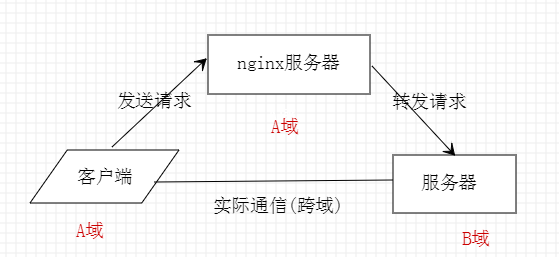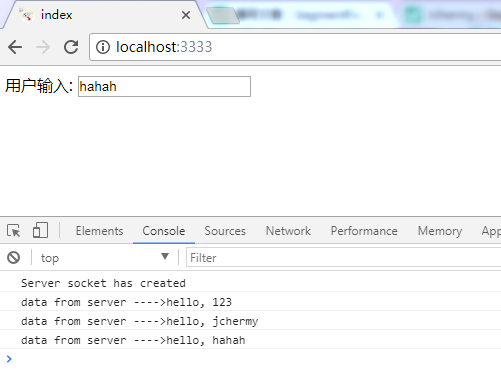前言
常言道,"读万卷书,不如行万里路"。技术的学习也是如此,唯有实践才能更清楚的明白原理和加深印象,因此本文会利用node.js对前端的各种跨域方式进行实践,强烈建议一步一步跟着做,相信你肯定会对跨域有更深层次的理解。而由于篇幅限制,本文只会贴出关键性的代码,本系列总共分为上下篇。具体的代码请移步我的Github。如果对你有帮助的话,欢迎 star ヾ(´・ω・`)ノ
接上文--->「跨域」利用node.js实践前端各种跨域方式(上)
六、window.postMessage
postMessage是HTML5 XMLHttpRequest Level 2中的API,且是为数不多可以跨域操作的window属性之一,它可用于解决以下方面的问题:
1.页面和其打开的新窗口的数据传递
2.多窗口之间消息传递
3.页面与嵌套的iframe消息传递
4.上面三个场景的跨域数据传递
用法:postMessage(data,origin)方法接受两个参数
data: html5规范支持任意基本类型或可复制的对象,但部分浏览器只支持字符串,所以传参时最好用JSON.stringify()序列化。
origin: 协议+主机+端口号,也可以设置为"*",表示可以传递给任意窗口,如果要指定和当前窗口同源的话设置为"/"。
来,我们来用node.js实践一下~
目录:postMessage/public/a.html
<!DOCTYPE html>
<html lang="en">
<head>
<meta charset="UTF-8">
<meta name="viewport" content="width=device-width, initial-scale=1.0">
<meta http-equiv="X-UA-Compatible" content="ie=edge">
<title>a</title>
<iframe id="iframe" src="http://localhost:4444/b.html" style="display:none;"></iframe>
</head>
<body>
<script>
const iframe = document.getElementById('iframe');
iframe.onload = function() {
const data = {
name : 'Jchermy'
};
//向http://localhost:4444 发送跨域数据
iframe.contentWindow.postMessage(JSON.stringify(data), "http://localhost:4444");
};
//接受 localhost:4444 返回的数据
window.addEventListener('message', function(e){
alert('data from b.html ----->' + e.data);
},false);
</script>
</body>
</html>在iframe加载完成后,向b.html所在域发送数据。因为postMessage是绑定在window对象上的,所以我们要获取iframe.contentWindow再发送数据,同时监听message,观察b.html有没有回传数据给我们。现在分别跑两个服务。访问localhost:3333可以看到:
b.html接收到a.html发送过去的数据啦~
然后a.html也收到了b.html回传的数据了。
跨域成功~ ( 。ớ ₃ờ)ھ
七、nginx 反向代理
这个方案的原理图如下:
说明:当A域想与B域通信,可以通过nginx的反向代理,首先A域与同域的nginx服务器通信,然后nginx将请求转发到另外一个服务器,因为服务器之间的通信不存在跨域,这样我们就完成了跨域。具体实现如下:
首先,如果本地没有安装nginx的,需要安装nginx。安装完成后,我们对nginx进行配置:
目录:nginx-1.14.0/conf/nginx.conf
server {
listen 1111;
server_name localhost;
location / {
proxy_pass http://localhost:9999/; #反向代理到9999端口
index index.html index.htm;
default_type "text/html";
alias "D:/Github/node-server/nginx/public/"; #client.html所在的本地的地址
add_header Access_Control_Allow_Origin http://localhost:1111;
add_header Access_Control_Allow_Credentials true; #允许客户端带cookie访问
}
然后,我们配置9999端口的服务器
目录:nginx/server.js
const http = require('http');
const server = http.createServer();
const qs = require('querystring');
server.on('request', function(req, res) {
const query = require('url').parse(req.url, true).query;
//向前台写cookie
res.writeHead(200, {
'Set-Cookie' : 'name=jchermy;Path:/;Domain:localhost;Httponly' //HttpOnly 脚本无法读取
});
res.write(JSON.stringify('Hi! '+query.user));
res.end();
})
server.listen('9999');
console.log('Server is running at port 9999 .....');这时候,我们打开浏览器,访问 http://localhost:1111/client.html?user=jchermy,看到下面的页面:
我们在1111端口,将user=jchermy传给9999端口,然后9999端口接收到了我们的发送的信息并回传了"Hi! jchermy".说明这两个url可以跨域相互通信!完成~
七、node.js 中间件跨域
这个方案与nginx反向代理十分类似,只是将nginx代理服务器换成了node服务器。
目录:node-middleware/proxyserver.js
const express = require('express');
const proxy = require('http-proxy-middleware');
const app = express();
app.use('/login', proxy({
//代理跨域的目标接口
target: 'http://localhost:5555',
changeOrigin: true,
//修改响应头信息,实现跨域,并允许带cookie
onProxyRes: function(proxyRes, req, res) {
res.header('Access-Control-Allow-Origin', 'http://localhost');
res.header('Access-Control-Allow-Credentials', 'true');
},
//修改响应信息中的cookie域名
cookieDomainRewrite: 'http://localhost'
}));
app.use(express.static( './public'));
app.listen(3333);
console.log('proxy server is listen at port 3333');目录:node-middleware/server.js
const http = require('http');
const server = new http.Server();
const qs = require('querystring');
server.on('request', function(request, response) {
const query = require('url').parse(request.url, true).query;
response.writeHead(200, {
'Set-Cookie': 'name=amiee;Path:/;Domain:localhost:3333;Httponly'
});
response.write(`Hi, ${query.name} ! I come from localhost:5555`);
response.end();
})
server.listen('5555');
console.log('Server is running at port 5555 .....')最后,访问http://localhost:3333/login?name=hahah,可以看到:
八、webSocket
WebSocket protocol是HTML5一种新的协议。它实现了浏览器与服务器全双工通信,同时允许跨域通讯,是server push技术的一种很好的实现。
原生WebSocket API使用起来不太方便,我们使用Socket.io,它很好地封装了webSocket接口,提供了更简单、灵活的接口,也对不支持webSocket的浏览器提供了向下兼容。
首先,我们创建一个客户端的html页面。
目录:webSocket/public/index.html
<!DOCTYPE html>
<html lang="en">
<head>
<meta charset="UTF-8">
<meta name="viewport" content="width=device-width, initial-scale=1.0">
<meta http-equiv="X-UA-Compatible" content="ie=edge">
<title>index</title>
</head>
<body>
<div>用户输入: <input type="text"></div>
<script src="https://cdnjs.cloudflare.com/ajax/libs/socket.io/2.1.1/socket.io.js"></script>
<script>
window.onload = function(){
var socket = io('http://localhost:5555');
//连接成功处理
socket.on('connect', function(){
console.log('Server socket has established');
});
socket.on('disconnect', function() {
console.log('Server sockect has closed');
});
//监听服务端消息
socket.on('message', function(msg) {
console.log('data from server ---->' +msg);
} )
document.getElementsByTagName('input')[0].onblur = function() {
socket.send(this.value);
};
}
</script>
</body>
</html>将这个页面部署在3333端口上。
目录:webSocket/client.js
const express = require('express');
const app = express();
app.use(express.static('./public'));
app.listen(3333);
console.log('client is running at port 3333....');最后,创建一个服务器,接收客户端的请求,并给予返回值
目录: webSocket/server.js
const http = require('http');
const socket = require('socket.io');
//启动http服务
const server = http.createServer(function(req, res) {
res.writeHead(200, {
'Content-type': 'text/html'
});
res.end();
})
server.listen(5555);
console.log('server is running at port 5555');
const io = socket(server);
//监听socket连接
io.on('connection', function (client) {
//接收消息
client.on('message', function (msg) {
io.emit('message', `hello, ${msg}`);
console.log('data from client --->' + msg);
});
//断开处理
client.on('disconnect', function() {
console.log('Client socket has closed');
});
});将客户端和服务器端都跑起来,输入一些字符,当鼠标失去焦点后可以在服务器端5555端口的控制台看到:
这说明服务器已经收到了客户端发送过去的字符。
此时在打开客户端页面的控制台,可以看到客户端也收到了服务器返回的字符:
结语
这个系列终于写完啦,还是那句话,有错误和不合理的地方欢迎大家指正!如果文章对你有帮助的话,欢迎点赞和收藏!!Github给个star就最好啦!=(//▽//)感谢大家~







**粗体** _斜体_ [链接](http://example.com) `代码` - 列表 > 引用。你还可以使用@来通知其他用户。